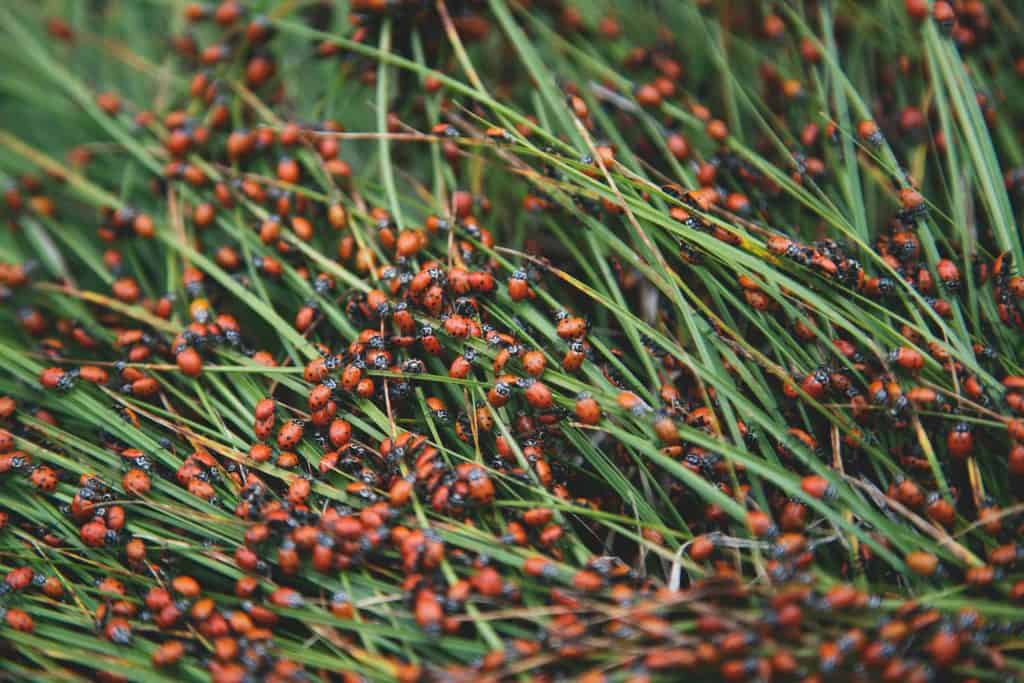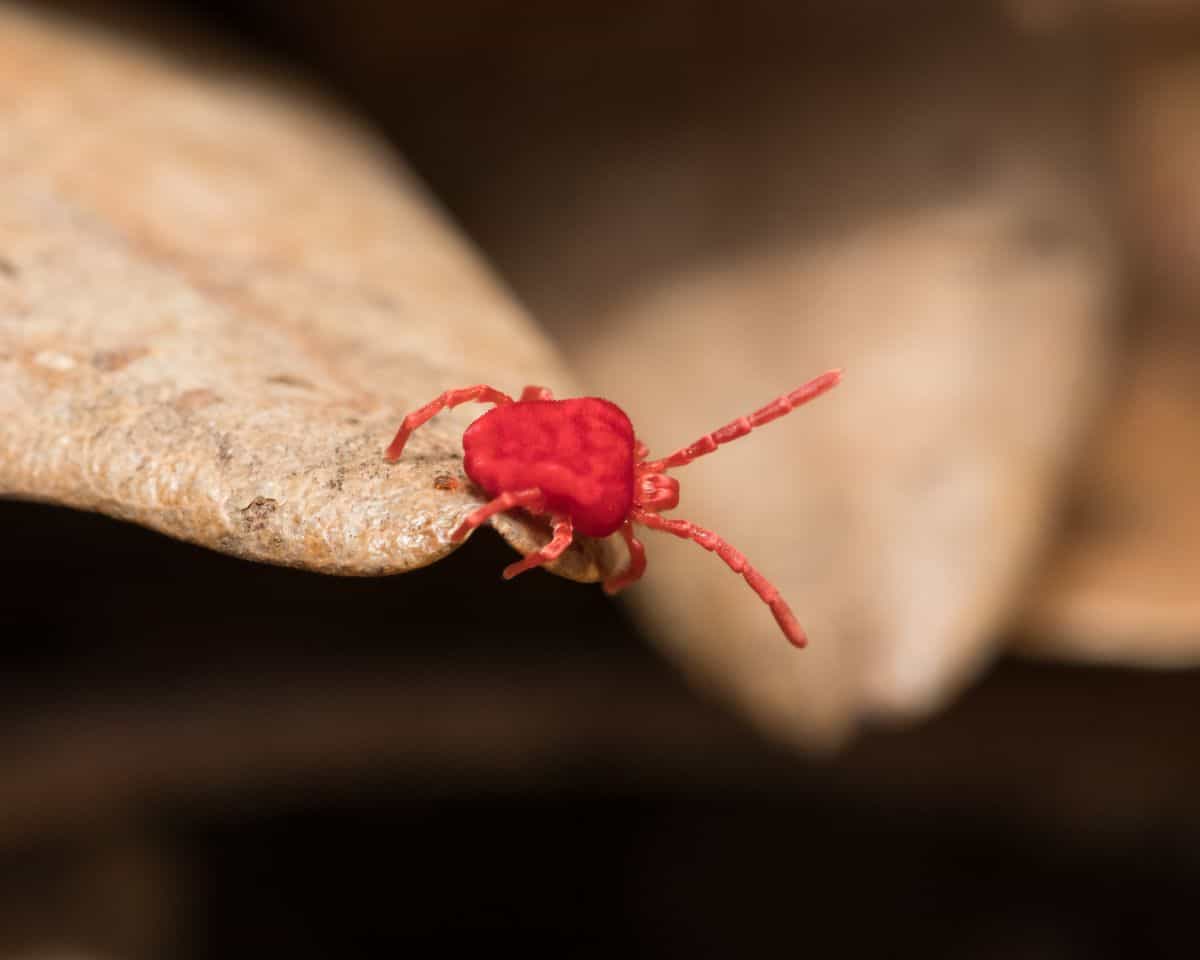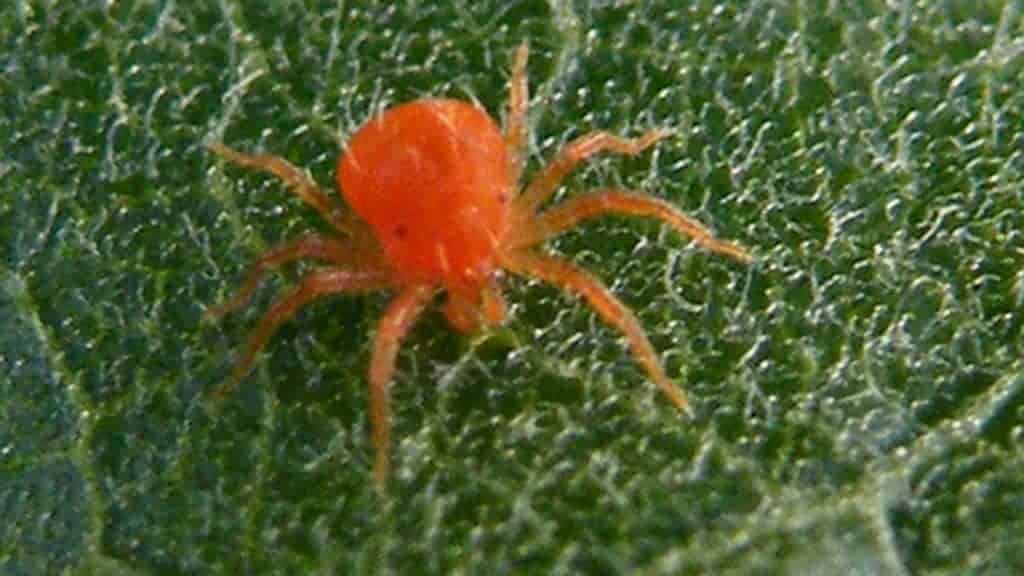When it comes to garden pests, identification is key in determining the best method of treatment. The more you know about the enemies invading your garden, the better prepared you’ll be when it comes to getting rid of them.
Spider mites and clover mites are two closely related pests that are found in gardens around the world. One is a common pest that feeds on succulents and cacti and the other prefers the taste of grass. So, how can you tell them apart?
Jump to:
Breaking It Down

Both spider mites and clover mites are found around the world, so, unfortunately, your location won’t help narrow down the identity of your garden’s intruders. Instead, you’ll need to take a closer look at the pest and the damage they’ve done.
Since both types of mites are related, and they’re both arachnids, they’ll have similar body structures along with eight legs. However, they do differ slightly in body shape and color.
Regardless of the type of mite invading your home or garden, there are steps you can take to get rid of any infestation. Mites are a common problem encountered by both new and experienced gardeners, so you can be sure that effective solutions are available.
Read Also: Best Grow Lights for Seedlings
Spider Mites

Despite the confusing name, spider mites are not spiders, but they are related. Both spiders and mites are part of the arachnid family, which simply means that they both have two body segments and eight legs.
Spider mites belong to a subfamily of mites called Tetranychidae. As you may have noticed, this is not the same subfamily as clover mites. Taxonomy is a complicated subject, but the point is that although spider mites and clover mites are related, it’s not a particularly close relationship.
The reason spider mites have been given this puzzling name is the webs they create on the underside of plant leaves. The webs of spider mites don’t serve the same purpose as those of actual spiders. Nor do they have the intricate patterns you’re familiar with.
Instead, spider mites build webs to protect themselves from predators. The webs themselves tend to be messy and unorganized. However, the webs are pretty conspicuous, so if you have a spider mite infestation, it definitely won’t go unnoticed.
See Also: Best Liquid Fertilizer
It should be noted that spider mites feed on plant material only and are not harmful to humans. It can be worrisome to notice a new infestation on your indoor plants but don’t worry, spider mites do not pose any danger to you or your family.
Appearance

Spider mites are incredibly tiny. In fact, they’re so small that you’re probably going to notice their webs or the damage they do to your plants before you notice the mites themselves.
There are different species of spider mites so they may vary slightly in appearance. Red Spider Mites, as you may guess, are a reddish-brown color. The Two-Spotted Spider Mite, on the other hand, tends to be more of a yellowish-green color with two large, dark spots on the sides of their bodies.
Regardless of the species of spider mites, you’re likely going to notice their webbing before you see the mites themselves. The webbing will be most evident on the undersides of your succulent leaves.
Damage
No products found.
The damage done to your succulents will also be an obvious sign of a spider mite infestation. The mites feed on the underside of the plant’s leaves. The mites puncture the leaves with their mouthparts, sucking the plant’s juices out.
The punctures of spider mites cause the leaf to develop tiny yellow or white spots called stippling. If your succulent or cactus has particularly thick leaves or stems, you may not notice the damage until it’s too late.
Severe spider mite infestations can seriously damage your succulents and even kill them, so it’s crucial that you monitor the health of your plants. Check your plants at least once per week and be sure to look at both the tops of the leaves and the undersides.
If you think you might have a spider mite infestation, you can confirm by closely examining the undersides of leaves. Look for tiny, moving spots, stippling, or webbing. You can also hold a piece of paper under your succulent leaves and gently shake them. If you have spider mites, they’ll fall onto the paper where they should be easier to spot.
See Also: Best Pots For Succulents
Life cycle
Unlike many other types of pests, spider mites prefer hot, dry weather. Sounds like the preferred climate of our favorite plants, right? Unfortunately, spider mites are also found around the world, so they’re a common pest no matter where you live.
From the moment they hatch, the entire lifespan of spider mites lasts only about a month. Under the right conditions, a spider mite colony’s population can explode in just a few weeks.
After hatching, larvae will reach adulthood in one to two weeks, depending on the temperature and weather. Some species can reach sexual maturity in as little as five days. Once a female is mature enough to mate, she is capable of laying up to 20 eggs per day.
This accelerated rate of reproduction can make population control rather difficult. Spider mites also adapt quickly to resist chemical pesticides when used consistently over a long period of time.
You can see why monitoring an infestation is so crucial to keeping it under control. If left untreated, the infestation can quickly spread throughout your entire garden.
Read Also: How to Get Rid of Whiteflies
Summary
- Feed on the underside of succulent leaves
- Found in hot, dry climates around the world
- Difficult to spot due to size
- Keep an eye out for stippling and webbing
- Reproduce quickly so treatment must be immediate
- Can become pesticide-resistant
Clover Mites

Although clover mites are also arachnids, they do not belong to the same subfamily as spider mites. Instead, they belong to the subfamily Bryobia, which just means that they’re a different type of mite than spider mites.
Read Also: Perlite vs Pumice (Which One Is Best?)
Clover mites feed exclusively on plant material, so you don’t need to worry about them causing harm to your family or pets. Even if you find them in your house, you don’t need to be concerned about them biting you or your loved ones.
However, it’s important to note that if you do find clover mites in your house, you need to remove them without crushing or squishing them. If you crush them, they leave behind red stains that can be difficult to remove.
The red stains might resemble those of bloodsucking insects, but fear not, the color is simply due to pigments in the mites’ bodies. Removing the mites with a vacuum is an easy way to remove them without risking any stains on your furniture or around your home.
Unfortunately, clover mites are found around the world, so it’s unlikely that you’ll be able to avoid them by living in certain areas. Although they don’t typically feed on succulents, you still may find them in your home or succulent garden as they spread in search of food.
Appearance
Adult clover mites are quite small, typically less than a millimeter in length as adults. This equates to a bit smaller than the size of a pinhead.
Though their color is difficult to discern from a distance, clover mites are usually a greenish-brown color with red or orange legs. You’ll likely see them in large numbers, where they will appear as a group of dark-colored specks.
If you were to look at a clover mite under magnification, you’d also notice they have a body that appears to have a wrinkled appearance with a pronged snout. Their first set of walking legs are also somewhat elongated. However, most gardeners don’t care to get this personal with clover mites.
See Related Topic: Best Soil Moisture Meter
Life Cycle

Clover mites prefer cooler, milder weather than spider mites. In fact, clover mites will die in temperatures over 100 degrees Fahrenheit. Temperatures under 75 degrees Fahrenheit will also cause clover mite eggs to go dormant.
The entire life cycle of a clover mite takes place over the span of about a month. After hatching, clover mites reach maturity after just a couple weeks.
As adults, female clover mites lay about 70 eggs each. This may not seem like much compared to spider mites, but it’s important to note that clover mites are parthenogenetic. This means that the eggs do not need to be fertilized in order to hatch.
The eggs develop using the female’s genetic material, which means that all clover mites are female. So, if each and every clover mite lays 70 eggs during its one-month lifetime, you can see how populations can grow so quickly.
Damage
Clover mites can cause serious damage to the plants that they infest. Luckily, they seem to prefer grasses and clover over succulents and cacti. However, this doesn’t mean that they won’t invade your succulent garden.
The plants that clover mites feed on will appear to have random silvery-white specks on the leaves. If an infestation is large enough, you’ll also notice large yellow patches on your lawn. Since populations can grow so quickly, the damage can be quite severe if left untreated.
Summary
- Unlikely to bother your succulents or cacti
- Prefer mild weather over extreme temperatures
- Will leave a red stain if crushed
- Leave white specks or streaks on grass blades and clover leaves
- Often invade homes in search of food or to escape the weather
How to Get Rid of Spider Mites and Clover Mites

Although water won’t get rid of all of your mites, a high-pressure blast of water will be enough to knock most of the pests of your plant. This can be a great first step in treatment as it quickly reduces the number of mites you have to deal with. Water also removes spider mites’ protective webbing, making them more vulnerable.
Neem oil is a great option for treating mites, but it’s best used in combination with other treatment methods. It’s also an effective preventative treatment, so if you think you could have an incoming infestation, you can apply it to your plants before the mites take hold.
Insecticidal soap is another effective method of removing mites. You can buy insecticidal soap at your local garden center or you can make your own at home. A few drops of soap, not detergent, in a spray bottle full of water, will be just as effective as the stuff you buy at the store.
If you plan on using either neem oil or insecticidal soap, it’s important to note that you need to apply them to the underside of the plant where the mites are in order for it to work. To do this, you may need to flip the plant over. By wrapping the soil of a potted plant in plastic wrap, you should be able to turn the plant over without making a mess. For outdoor plants, you’ll just need to be careful about applying the spray evenly on the underside of the plant.
Natural predators are another possibility if you’re looking for a natural remedy for mites in your succulent garden. There are quite a few species of harmless mites that feed on other mites. Predatory mites will not harm your plants, only the pests invading your garden. However, natural predators are really only effective as maintenance, rather than a treatment for a huge infestation.
Since there are so many natural and effective treatments for mites, we don’t recommend using chemical pesticides. Using harsh chemicals on your plants not only puts them at risk but you as well. Many pesticides can be harmful if inhaled or absorbed through the skin. Additionally, pests can quickly become resistant to chemical pesticides over time, so it’s best to use other treatment methods if possible.
If you’re worried about clover mites invading your house or succulent garden, you can try removing nearby grasses and clover. Leaving a strip of bare earth or decorative rocks are often enough to deter them from finding their way into your house or succulents.
If you’re looking for more detailed information on treating mites, click here. No matter what type of treatment you choose, it’s important to monitor your plants closely until you’re certain that you’ve eliminated the current mite population.
You Might Also Like:

